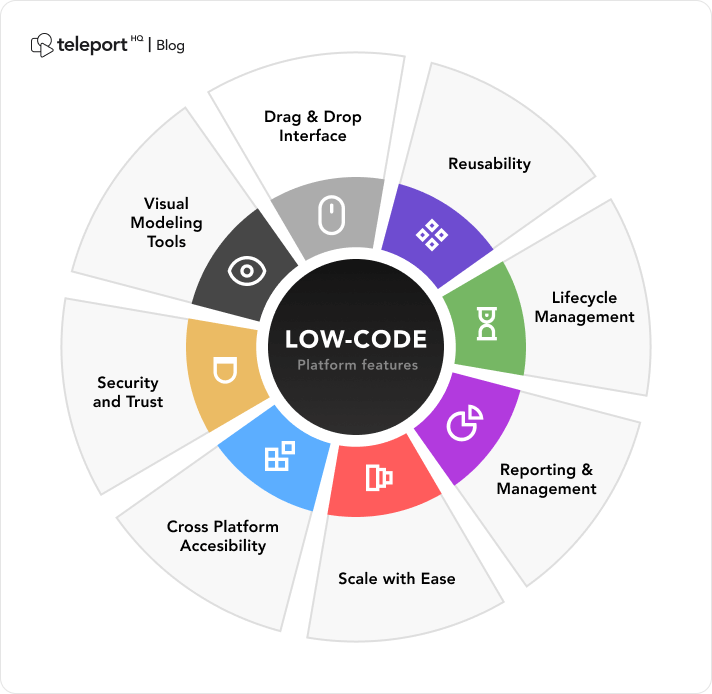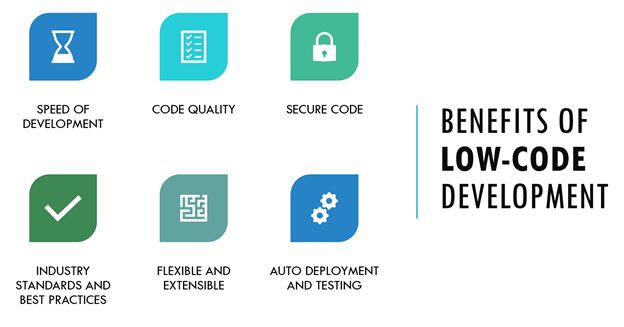Free Facts For Choosing Low-Code Platform Examples
Wiki Article
Advantages Of Low Code Application Development For Non-Developers
Low-code development of applications significantly increases accessibility for non-developers. Often, they are referred to as "citizen developers" due to several key factors. Intuitive Visual Interfaces:
Drag-and -Drop Builders. Low-code platforms come with drag-and -drop interfaces. This provides non-programmers with the ability to create applications in a visual manner, without writing code. This allows development to be more accessible to people without technical background.
WYSIWYG Editors: "What You See Is What You Get" editors allow users to design interfaces and workflows in an approach that is similar to the final product, making it easier to use and understand.
Simplified Workflow and Logic Design:
Visual Workflow Modeling: Users are able to develop business processes, applications logic and flowcharts by using models as well as visual flowcharts. These methods are much more intuitive than traditional methods of coding.
Low-code platforms typically come with pre-built logic elements (e.g. the conditional statements, loops) that eliminate the requirement for complex coding.
Reusable templates and components:
Libraries of prebuilt templates Low-code platforms typically offer templates from libraries for the most popular types of applications. This gives non-programmers the ability to begin with a solid foundation and customize it as required.
Reusable Widgets and Modules Users can use reusable widgets. This allows for a simpler creation and reduces the need of in-depth understanding.
Guided Development & Tutorials
Step-by-Step Instructions Platforms typically offer tutorials on screen, guiding development routes as well as other tools to assist developers who are not developers create apps.
Interactive Tutorials Interactive tutorials that let you engage with the platform will aid in learning and increase confidence.
Integration with existing tools:
Seamless integration Low-code platforms are created to be able to seamlessly integrate with existing business systems and tools (e.g. CRM, ERP) allowing non-developers create applications within their current workflows.
APIs/Connectors: The APIs/Connectors built-in allow non-developers to connect their apps to external services.
Collaboration Features:
Team Collaboration Features, such as real-time collaboration as well as shared workspaces, enable non-developers and professionals to collaborate effectively.
Role-based access control: Access levels can be set for non-developers to ensure they can still contribute to the development process, but without compromising the security.
Automated Testing & Debugging
Low-code platforms are often equipped with debugging and testing software that can automatize these procedures. This makes it much easier for non-developers to ensure that their applications function correctly.
Error Highlighting Whenever errors are detected the platform highlights them and suggests solutions. It guides non-developers in solving the issue.
The general rule is that low-code development is able to democratize development. This is a major benefit for developers who are not. Low-code platforms allow business users to be involved in the creation and development of apps by offering visual tools and guided experience. This is a bridge between the technical implementation and business needs. Follow the most popular top article for Low-code Platform for application development for website tips including driver jdbc, sso azure, stored sql procedures, sso azure, lowcode no code, mobile app development platforms, application development platforms, develop cross platform mobile app, cloud software applications, application development platforms and more.

Low-Code Applications Are Cost-Effective.
Low-code application development offers numerous advantages when it comes to cost-efficiency, making it an attractive alternative for companies seeking to optimize their development budgets while still delivering top-quality software. The main benefits are: Reduced costs for development:
A Less Code Required Low-code platforms eliminate the requirement for a lot of hand-coding, which reduces the amount of time and effort developers need to spend on building applications. This results in lower labor costs.
Fewer Developer Resources: Since low-code development is more efficient and simpler, fewer specialized developers are needed. The cost of hiring and staffing could be significantly reduced.
Faster Time to Market
Development speed up Visual tools for development and pre-built parts provided by platforms that use low-code allow rapid design of applications, which allows companies to get their products on the market faster. This will result in faster revenues and better positioning in the market.
Rapid prototyping: By developing rapid prototypes and testing them quickly companies can decrease the time they spend in the process of development and also allow for faster revisions based on user feedback.
Lower cost of maintenance:
Because of their modular architecture and common components, low-code platforms usually simplify the maintenance of applications. This reduces the ongoing maintenance and support cost.
Automated Updates: A lot of low-code platforms handle patches and updates in a way that is automatic, ensuring applications remain secure and up-to date without needing large manual intervention.
Efficient Resource Utilization:
Contributions by Non-Developers Low-code platforms allow non-developers and business users to take part in the development process. This is a way for developers to be more democratic and allows businesses and employees to work together, thus reducing the dependence on highly paid developers.
Utilizing IT resources efficiently IT departments are given the ability to focus on more strategic projects instead of getting bogged down with mundane development tasks. Overall productivity and efficiency are improved.
Price models that can be scaled:
Subscription-Based Pricing: Many low-code platforms offer flexible, subscription-based pricing that can scale according to the amount of usage. This lets businesses align spending with actual needs and growth, while avoiding huge initial costs.
Pay-Asss-You-Go Option: Some platforms offer pay-ass-you-go options that make sure businesses only pay when they make use of resources. This is particularly helpful for startups and smaller businesses with limited budgets.
Reduced Third-Party Software Costs:
Built-in Functionalities: Low code platforms come with many integrated features and integrations which make it less necessary to use third-party tools and programs. Subscription fees and licensing fees are also reduced.
Pre-Built integrations: These pre-built systems and services can be integrated with other well-known services, reducing the requirement for custom-designed software, which saves time and money.
Improved ROI
Increased Return On Investment The combination of speedy development and lower costs with a faster time to marketing allows businesses to get a greater return on their investment.
Improved Agility: Businesses can rapidly adapt to market trends and customer needs to ensure they remain current and take advantage of new opportunities that arise.
Low Cost Training:
User-Friendly Interfaces: Low-code platforms are user-friendly and have simple interfaces that reduce the time required to learn.
Accessible resources: Many low-code platforms have complete tutorials, instructional materials, as well as community support, reducing the requirement for formal education.
Collaboration can be made more efficient.
Improved Collaboration Tools Collaboration tools are integrated into the workflow. This allows improved collaboration between team members, as well as an improvement in overhead for projects.
Unified Development Environment. A single integrated software development environment can streamline processes and decrease the cost and complexity of managing multiple software and platforms.
In general, low-code apps are cost-effective due to their ability to lower costs of development and maintenance as well as to speed time-to-market, to optimize the use of resources and to allow for flexible pricing. All of these factors provide substantial financial benefits to businesses, making low-code a compelling option for companies looking to increase their budgets for development while also delivering high-quality, flexible, and high-quality applications. Follow the most popular Enterprise application development with Low-code Platform for blog tips including mobile development platforms, no code platforms, low code platforms, build with docker, cross platform mobile dev, rad development, rapid applications, jdbc server, cloud software applications, cross platform mobile development and more.

Advantages Of Developing Applications Using Low-Code In Terms Of Limitations And Customization
Low-code development is a balanced approach to addressing limitations, while also allowing the possibility of customizing. These are the advantages:
Beating Complexity Barriers
Simplified Development: Low-code platforms minimize the complexity of development by providing templates and components that are pre-built, enabling rapid development and deployment for complicated applications.
Many platforms feature guided workflows, which assist developers navigate through complicated procedures. They decrease the chances of making mistakes and help maintain consistency.
Scalability Solutions:
Scalability is a part of the Low-code platforms typically include features that enable an architecture that is scalable. Applications can handle increased loads with minimal changes.
Performance Monitoring Performance Monitoring: Tools for monitoring performance and optimization tools ensure that the applications run as efficiently as they can be, no matter their size.
Security and Compliance
Integrated Security Features : Low codes platforms have security measures built in including encryption and access control based on role. They also perform automated checks for compliance to deal with security concerns.
Platforms update frequently their security protocols and ensure compliance with regulatory requirements. This keeps platforms safe from new threats.
Customization Capabilities:
Extensibility:
Low-code platforms are often able to incorporate custom code, for instance, JavaScript or Python which allows developers to expand their capabilities beyond the limitations of typical.
Custom Plugins and Modules Developers are able to create custom modules or plugins to include specific functions that are tailored to specific business needs.
APIs and integration
API Support: Comprehensive API support allows seamless integration of external systems and services. This facilitates extensive customization and connectivity.
Low-Code Platforms: These platforms provide built-in connectors for popular third-party service providers, making it simple to integrate and customize apps.
Flexible UI/UX:
Customizable user interfaces: Developers can alter and design user interfaces in order to satisfy specific branding requirements and usability needs, providing a tailored experience for users.
Responsive design: The ability to tailor applications for various screens and devices is included.
Business Logic Customization
Visual Workflow Builders - Visual tools to build and modify workflows. business logic and procedures allow developers to develop complex and tailored processes without extensive programming.
Conditional Logic & Scripting: Platforms allow the use of conditional logic and scripting that is custom-made to handle specific business rules.
Data Management
Custom Data Models: Developers can define custom data models to suit specific application needs to ensure that data processing is tailored to business requirements.
Advanced Data Processor: The combination of sophisticated data processing tools and capabilities permits the customisation of the method by which data is processed and used within the application.
Balance Customization and Limitations
Frameworks and Standards:
Low-code platforms encourage industry standards and best practices, resulting in high-quality applications that are flexible and secure.
Governance Frameworks - Built-in governance structures ensure that customizations don't interfere with security, integrity or compliance.
Iterative development and feedback:
Rapid prototyping: Developers are able to quickly test and prototype customizations using the feedback of users, and improve the app in line with their preferences.
Continuous Improvement: Low-code systems permit continuous improvement, which allows for constant customization and enhancements as business requirements evolve.
User Empowerment:
Empowering Citizen developers: Low-code platform's intuitive interfaces let non-developers modify the application. This increases the number of users who are able to modify and improve applications.
Training and support: Many platforms include extensive training resources as well as support services to help users in creating customizations which are efficient without compromising an application's performance or stability.
Overall, Low-code application creation offers a framework that is robust and flexible enough to accommodate restrictions while allowing the possibility of extensive customisation. This balance allows companies to create and maintain applications that function, are tailored to their particular requirements and adhere to high standards in terms of security, quality and scalability.
